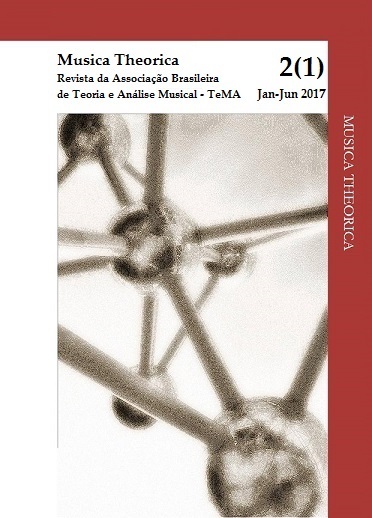Form, Topics, and Harmonic Schemata in Beethoven’s String Quartet Op. 18 No. 4/I, in C Minor
DOI:
https://doi.org/10.52930/mt.v2i1.36Resumo
Bridging the gap between different cultural contexts such as the one between a modern listener and an 18th-century listener has been a constant interest of contemporary musicologists and theorists— especially those dedicated to the study of galant schemata, topic theory, and formal functions. Although these theories are usually used separately when analysing a musical discourse, recent studies have been leaning on the benefits of entwining them in order to build a richer understanding of a piece of music. Therefore, the aim of this paper is to present an analysis of the first movement of Beethoven’s String Quartet in C Minor, Op. 18 No. 4 where all of the aforementioned analytical techniques are used to better expose different levels of interpretation that emerge from overlapping topic theory, formal functions, and galant schemata analyses.
Referências
Allanbrook, Wye J. 1983. Rhythmic Gesture in Mozart: Le nozze di Figaro and Don Giovanni. Chicago: University of Chicago Press.
_________________. 2014. Secular Commedia: Comic Mimesis in Late Eighteenth-Century Music. Edited by Mary Ann Smart and Richard Taruskin. Berkeley: University of California Press.
Byros, Vasili. 2014. Topics and Harmonic Schemata: A Case from Beethoven. In: The Oxford Handbook of Topic Theory, p. 381-414. Danuta Mirka (ed.). Oxford: Oxford University Press.
Caplin, William E. 1998. Classical Form: A Theory of Formal Functions for the Instrumental Music of Haydn, Mozart, and Beethoven. New York: Oxford University Press.
_________________. 2005. On the Relation of Musical Topoi to Formal Function. Eighteenth-Century Music vol. 2, no. 1, p. 113–124.
Cobley, Paul. 2008. Communication and verisimilitude in the eighteenth century. In: Communication in Eighteenth-Century Music, p. 14-33. Danuta Mirka and Kofi Agawu (eds.). Cambridge: Cambridge University Press.
Day-O’Connel, Sarah. 2014. The Singing Style. In: The Oxford Handbook of Topic Theory, p. 238–259. Danuta Mirka (ed.). Oxford: Oxford University Press.
Gjerdingen, Robert O. 2007. Music in the Galant Style. New York: Oxford University Press.
Hatten, Robert S. 1994. Musical Meaning in Beethoven: Markedness, Correlation, and Interpretation. Bloomington: Indiana University Press.
______________. 2014. The Troping of Topics in Mozart’s Instrumental Works. In: The Oxford Handbook of Topic Theory, p. 514–539.Danuta Mirka (ed.). Oxford: Oxford University Press.
Hepokosky, James; Warren, Darcy. 2006. Elements of Sonata Theory: Norms, Types, and Deformations in the Late-Eighteenth-Century Sonata. New York: Oxford University Press.
Hunter, Mary. 2014. Topics and Opera Buffa. In: The Oxford Handbook of Topic Theory, p. 61–90. Danuta Mirka (ed.). Oxford: Oxford University Press.
Ivanovitch, Roman. 2011. Mozart’s Art of Retransition. Music Analysis, vol. 30, no. 1, p. 1–36.
Kallberg, Jeffrey. 1996. Chopin at the Boundaries: Sex, History, and Musical Genre. Cambridge: Harvard University Press.
Little, Meredith E. 1975. The Contribution of Dance Steps to Musical Analysis and Performance: ‘La Bourgogne’. Journal of the American Musicological Society, vol. 28, no. 1, p. 112–124.
McClelland, Clive. 2014. Ombra and Tempesta. In: The Oxford Handbook of Topic Theory, p. 279–300. Danuta Mirka (ed.). Oxford: Oxford University Press.
Mirka, Danuta. 2008. Introduction. In: Communication in Eighteenth-Century Music, p. 1-10. Danuta Mirka and Kofi Agawu (eds.). Cambridge: Cambridge University Press.
Ratner, Leonard G. 1985. Classic Music: Expression, Form and Style. New York: Schirmer Books.


